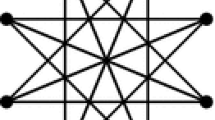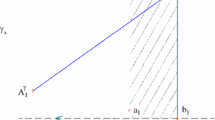Abstract
For many fundamental problems in computational topology, such as unknot recognition and 3-sphere recognition, the existence of a polynomial-time solution remains unknown. A major algorithmic tool behind some of the best known algorithms for these problems is normal surface theory. However, we currently have a poor understanding of the computational complexity of problems in normal surface theory: many such problems are still not known to have polynomial-time algorithms, yet proofs of \(\mathrm {NP}\)-hardness also remain scarce. We give three results that provide some insight on this front. A number of modern normal surface theoretic algorithms depend critically on the operation of finding a non-trivial normal sphere or disc in a 3-dimensional triangulation. We formulate an abstract problem that captures the algebraic and combinatorial aspects of this operation, and show that this abstract problem is \(\mathrm {NP}\)-complete. Assuming \(\mathrm {P}\ne \mathrm {NP}\), this result suggests that any polynomial-time procedure for finding a non-trivial normal sphere or disc will need to exploit some geometric or topological intuition. Another key operation, which applies to a much wider range of topological problems, involves finding a vertex normal surface of a certain type. We study two closely-related problems that can be solved using this operation. For one of these problems, we give a simple alternative solution that runs in polynomial time; for the other, we prove \(\mathrm {NP}\)-completeness.

















Similar content being viewed by others
Notes
For brevity, we usually drop the word “generalised”.
References
Agol, I.: Knot genus is NP. Conference presentation (2002)
Burton, B.A.: Minimal triangulations and normal surfaces. PhD thesis, The University of Melbourne (2003)
Burton, B.A.: Computational topology with Regina: algorithms, heuristics and implementations. In: Geometry and Topology Down Under. Contemporary Mathematics, vol. 597, pp. 195–224. American Mathematical Society, Providence (2013)
Burton, B.A.: A new approach to crushing 3-manifold triangulations. Discrete Comput. Geom. 52(1), 116–139 (2014)
Burton, B. A., Budney, R., Pettersson, W., et al.: Regina: software for low-dimensional topology. https://regina-normal.github.io (1999–2017)
Burton B.A., Özlen, M.:A fast branching algorithm for unknot recognition with experimental polynomial–time behaviour.Mathmatical programming (2012) in press
Garey, M.R., Johnson, D.S.: Computers and Intractability: A Guide to the Theory of NP-Completeness. W. H. Freeman & Co., New York (1979)
Haken, W.: Theorie der Normalflächen. Acta Math. 105, 245–375 (1961)
Hass, J., Lagarias, J.C., Pippenger, N.: The computational complexity of knot and link problems. J. ACM 46(2), 185–211 (1999)
Ivanov, S.V.: The computational complexity of basic decision problems in 3-dimensional topology. Geom. Dedic. 131(1), 1–26 (2008)
Jaco, W., Oertel, U.: An algorithm to decide if a 3-manifold is a Haken manifold. Topology 23(2), 195–299 (1984)
Jaco, W., Rubinstein, J.H.: 0-efficient triangulations of 3-manifolds. J. Differ. Geom. 65(1), 61–168 (2003)
Jaco, W., Tollefson, J.L.: Algorithms for the complete decomposition of a closed 3-manifold. Ill. J. Math. 39(3), 358–406 (1995)
Lackenby, M.: The efficient certification of knottedness and Thurston norm. arXiv Mathematics e-prints (2016). arXiv:1604.00290
Rubinstein, J.H.: One-sided Heegaard splittings of 3-manifolds. Pac. J. Math. 76(1), 185–200 (1978)
Schaefer, T.J.: The complexity of satisfiability problems. In: Proceedings of the Tenth Annual ACM Symposium on Theory of Computing, pp. 216–226. Association for Computing Machinery, New York (1978)
Schleimer, S.: Sphere recognition lies in NP. In: Usher, M. (ed.) Low-Dimensional and Symplectic Topology. Proceedings of Symposia in Pure Mathematics, vol. 82, pp. 183–213. American Mathematical Society (2011)
Zentner, R.: Integer homology 3-spheres admit irreducible representations in \({\rm SL}(2, {\mathbb{C}})\). Duke Math. J. 167(9), 1643–1712 (2018)
Author information
Authors and Affiliations
Corresponding author
Additional information
Publisher's Note
Springer Nature remains neutral with regard to jurisdictional claims in published maps and institutional affiliations.
Rights and permissions
About this article
Cite this article
Burton, B.A., He, A. On the hardness of finding normal surfaces. J Appl. and Comput. Topology 5, 583–619 (2021). https://doi.org/10.1007/s41468-021-00076-0
Received:
Revised:
Accepted:
Published:
Issue Date:
DOI: https://doi.org/10.1007/s41468-021-00076-0




